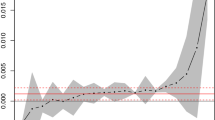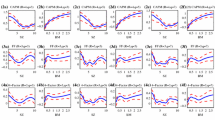Abstract
Empirical test of asset-pricing models are typically performed on portfolios based on firm-characteristics such as size and book-to-market ratios etc. However, because of their strong factor structure, the characteristic sorted portfolios do not provide a sufficient test for asset pricing models. In recent, the appropriateness to use characteristics sorted portfolios has been debated. Literature suggests various alternative test portfolios sorted by other attributes to improve the empirical tests. To address this issue, we construct three sets of test portfolios sorted by firm beta, volatility, and clustering method to test various asset pricing models. We examine whether portfolios sorted by the above methods can improve the explanatory power of various alternative asset pricing models. Our test results suggest that for unconditional models, the statistical significance and estimated risk premiums depend on the choice of tests portfolios. The conditional model has more power to explain the variation of average returns than the unconditional model.
Similar content being viewed by others
Notes
BSE Ltd, the first ever stock exchange in Asia & the fastest Stock Exchange in world with the speed of 6 μs established in 1875 and have more than 5500 companies listed on BSE. The companies listed on BSE Ltd. command a total market capitalization of USD 1.64 Trillion as of September 2015. SENSEX is India's most widely tracked stock market benchmark index. Source: http://www.bseindia.com.
References
Agarwalla, S. K., Jacob, J., Varma, J. R., & Vasudevan, E. (2014). Betting against beta in the Indian market, W.P. No. 2014-07-01. Ahmedabad: Indian Institute of Management.
Ahn, D. H., Conrad, J., & Dittmar, R. F. (2009). Basis assets. Review of Financial Studies, 22(12), 5133–5174.
Ang, A., Hodrick, R. J., Xing, Y., & Zhang, X. (2006). The cross-section of volatility and expected returns. Journal of Finance, 59(1), 259–299.
Ang, A., Liu, J., & Schwarz, K. (2016). Using stocks or portfolios in tests of factor models. Working paper, NBER.
Ansari, V. A., & Khan, S. (2012). Momentum anomaly: Evidence from India. Managerial Finance, 38(2), 206–223.
Banz, R. W. (1981). The relationship between return and market value of common stocks. Journal of Financial Economics, 9(1), 3–18.
Barras, L. (2018). A large-scale approach for evaluating asset pricing models. Journal of Financial Economics. https://doi.org/10.2139/ssrn.2081913.
Basu, S. (1977). Investment performance of common stocks in relation to their price–earnings ratios: A test of the efficient market hypothesis. Journal of Finance, 32(3), 663–682.
Bhandari, L. C. (1988). Debt/equity ratio and expected common stock returns: Empirical evidence. Journal of Finance, 43(2), 507–528.
Black, F., Jensen, M. C., & Scholes, M. (1972). The capital asset pricing model: Some empirical tests. In M. C. Jensen (Ed.), Studies in the theory of capital markets (pp. 79–124). Praeger: Praeger Publishers Inc.
Brown, S. J., & Goetzmann, W. N. (1997). Mutual fund styles. Journal of Financial Economics, 43(3), 373–399.
Cakici, N., Fabozzi, F., & Tan, S. (2013). Size, value, and momentum in emerging market stock returns. Emerging Markets Review, 16, 46–65.
Carhart, M. M. (1997). On persistence in mutual fund performance. Journal of Finance, 52(1), 57–82.
Cochrane, J. H. (2005). Asset pricing. Princeton and Oxford: Princeton University Press.
Daniel, K., & Titman, S. (2012). Testing factor-model explanations of market anomalies. Critical Finance Review, 1(1), 103–139.
Das, S. (2015). Empirical evidence of conditional asset pricing in Indian stock market. Economic Systems, 39(2), 225–239.
Das, S., & Barai, P. (2016). Size, value and momentum in stock returns: Evidence from India. Macroeconomics and Finance in Emerging Market Economies, 9(3), 284–302.
Ecker, F. (2013). Asset pricing tests using random portfolios. Duke University, The Fuqua School of Business. https://faculty.fuqua.duke.edu/~fecker/Ecker2013.pdf. Accessed July 2017.
Falkenstein, E. (1994). Mutual funds, idiosyncratic variance, and asset returns. PhD Dissertation. Northwestern University.
Fama, E. F., & French, K. R. (1989). Business conditions and expected returns on stocks and bonds. Journal of Financial Economics, 25(1), 23–49.
Fama, E. F., & French, K. R. (1992). The cross-section of expected stock returns. Journal of Finance, 47(2), 427–465.
Fama, E. F., & French, K. R. (1993). Common risk factors in the returns on stocks and bonds. Journal of Financial Economics, 33, 3–56.
Fama, E. F., & French, K. R. (2015). A five-factor asset pricing model. Journal of Financial Economics, 116, 1–22.
Fama, E. F., & MacBeth, J. D. (1973). Risk, return, and equilibrium: Empirical tests. Journal of Political Economy, 81(3), 607–636.
Ferson, W. E., & Harvey, C. R. (1999). Conditioning variables and the cross section of stock returns. Journal of Finance, 54(4), 1325–1360.
Ferson, W. E., & Schadt, R. (1996). Measuring fund strategy and performance in changing economic conditions. Journal of Finance, 51(2), 425–462.
Ghysels, E., & Jacquier, E. (2006). Market beta dynamics and portfolio efficiency. Working paper, University of North Carolina and HEC Montreal. http://ssrn.com/abstract=711942. Accessed March 2013.
Kan, R., Robotti, C., & Shanken, J. (2013). Pricing model performance and the two-pass cross sectional regression methodology. Journal of Finance, 68(6), 2617–2649.
King, M. R. (2009). The cost of equity for global banks: A CAPM perspective from 1990 to 2009. BIS Quarterly Review, Bank for International Settlements, September, pp 59–73
Levy, H. (1978). Equilibrium in an imperfect market: A constraint on the number of securities in the portfolio. The American Economic Review, 68(4), 643–658.
Lewellen, J., Nagel, S., & Shanken, J. (2010). A skeptical appraisal of asset pricing tests. Journal of Financial Economics, 96(2), 175–194.
Lo, A. W., & MacKinlay, A. C. (1990). Data-snooping biases in tests of financial asset pricing models. Review of Financial Studies, 3(3), 431–467.
Malkiel, B. G., & Xu, Y. (2002). Idiosyncratic risk and security returns. University of Texas at Dallas, Unpublished.
Murtazashvilia, I., & Vozlyublennaia, N. (2013). When do characteristics-sorted factors mechanically explain returns? Journal of International Financial Markets, Institutions and Money, 25, 119–143.
Nanda, S. R., Mahanty, B., & Tiwari, M. K. (2010). Clustering Indian stock market data for portfolio management. Expert Systems with Applications, 37, 8793–8798.
Phalippou, L. (2007). Can risk-based theories explain the value premium? Review of Finance, 11(2), 143–166.
Polkovnichenko, V., Xu, Y., & Zhao, Y. (2012). Simulation-based analysis of asset pricing model. Working papers, University of Texas, Dallas.
Pukthuanthong, L. K., & Visaltanachoti, N. (2009). Idiosyncratic volatility and stock returns: A cross country analysis. Applied Financial Economics, 19(16), 1269–1281.
Rahman, S., Schneider, M. J., & Antonacci, G. (2015). Tests of alternative asset pricing models using individual security returns and a new multivariate F-test. https://www.researchgate.net/publication/286379243. Accessed July 2017.
Rosenberg, B., Reid, K., & Lanstein, R. (1985). Persuasive evidence of market inefficiency. Journal of Portfolio Management, 11(3), 9–16.
Santos, T., & Veronesi, P. (2006). Labor income and predictable stock returns. Review of Financial Studies, 19(1), 1–44.
Sehgal, S. (1997). An empirical testing of three parameter capital asset pricing model in India. Finance India, 11(4), 919–940.
Shanken, J. (1992). On the estimation of beta-pricing models. Review of Financial Studies, 5(1–2), 1–33.
Shanken, J., & Zhou, G. (2007). Estimating and testing beta pricing models: Alternative methods and their performance in simulations. Journal of Financial Economics, 84(1), 40–86.
Sumathi, S., & Sivanandam, S. N. (2006). Introduction to data mining and its applications. Berlin: Springer.
Author information
Authors and Affiliations
Corresponding author
Additional information
Publisher's Note
Springer Nature remains neutral with regard to jurisdictional claims in published maps and institutional affiliations.
Rights and permissions
About this article
Cite this article
Das, S. Asset Pricing Test Using Alternative Sets of Portfolios: Evidence from India. Asia-Pac Financ Markets 26, 339–354 (2019). https://doi.org/10.1007/s10690-018-09268-8
Published:
Issue Date:
DOI: https://doi.org/10.1007/s10690-018-09268-8




